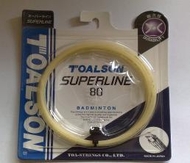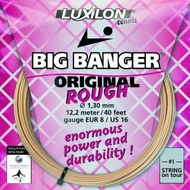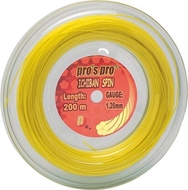JFC-TENNIS: Guide to Tennis Strings

Stringing Material
In the past, all rackets were strung with gut produced from the intestines of cattle or sheep. The intestines of two cows were needed to manufacture one set of gut strings.
The fabrication process is very labour intensive, and gut string is therefore more expensive. They are also more fragile, less durable and less resistant to damage from moisture and humidity than synthetic strings. So, why play with gut? A comparison of gut and first grade synthetic gut string at the same tension suggests that gut strings give slightly higher post- impact ball velocities, improved control and better racket “feel”. Gut strings also have greater resilience and better dampening qualities to that of synthetic strings.
This page explains the different types of tennis strings that are available on the market, there Advantages & Disadvantages and which string would suit what player!
The Tennis String Market is huge; there are a lot of brands to choose from and different types of strings that you must consider. Every string has its own unique characteristic which will make it different from its rivals – Have a look at the variety of strings that JFC-TENNIS sells.
All Brands will offer something different such as – Gauge, Colour, Surface, texture, structure, material – there are 8 different types of tennis string available these are: Natural Gut, Synthetic Gut, Nylon, Polyester, Titanium, Multifilament, Structured, and Hybrid which can be divided into two main categories – Natural Gut & Synthetic Gut.
Natural Gut
Natural Gut has always been considered the “best” String since the 1800’s – it has and remains the most frequent string used on the pro tour.
Natural Gut strings are made of the cow's gut with features that include Superb elasticity, tension stability and liveliness (pop).
Natural Gut Strings tend to be very expensive and can dramatically change depending on weather conditions.
As suggested earlier many professional tennis players still use Natural gut as their main string but we don’t recommend it for a normal club level player – due to its high cost and durability. Having said that many players argue that natural gut costs more than a multifilament synthetic, but to many players the performance more than justifies the expense.
Synthetic Strings
Synthetic strings are one of the most commonly used strings for your “everyday player” Synthetic Gut strings are constantly being improved to bring their playability into line with natural gut strings but keep the advantage of the synthetic materials thus meaning - higher durability. There's a great variety of structures and materials. Let me briefly explain the main categories:
Nylon Strings
The most frequently used string type. Nylon strings are generally good quality and low cost tennis strings and are normally made of a single nylon core and various resistant wraps.
Due to its nylon (polyamide) material it is well suited for tennis strings.
The number of different types of constructions - wrap material and wrap angle influence the string's playing characteristics significantly. Nylon strings with multiple wraps can be considered higher grade than single wrap nylon strings. The wraps reduce the tension loss usually experienced with nylon strings. Nylon strings are suitable for players who have normal or high string consumption.
Polyester Strings
Polyester strings show a fairly simple structure: they consist of a single polyester fibre with a thin coating. This type of construction is termed "monofilament". They come in different gauges (1.10-1.35mm), which enables you to choose among different elasticity/durability levels.
Polyester strings tend to be less elastic and feel quite stiff compared to nylon or multifilament strings, but on the other hand they provide better durability, allowing for the use of thinner gauges.
Polyester strings are highly recommendable for players with high string consumption. For these players, polyester strings offer a great price/performance ratio. Having said that, polyester string are constantly becoming more demanding and now use exceptional technologies to achieve superb playability.
Titanium Strings
Titanium string are not overly that popular anymore but they are based on Nylon or multifilament strings, the titanium is either applied with the coating of the string, protecting the material from UV radiation and abrasion, or the titanium is integrated into the filaments to modify the playability of the string.
Multifilament Strings
Multifilament strings were introduced to bring synthetic strings' playability more into line with natural gut, many microfibers are twisted together to a string, which is wrapped with a resistant cover to create a multifilament.
This brings advantages and disadvantages:
Advantage: Higher elasticity and better playability.
Disadvantage: Multifilament strings tend to break soon once the outer wrap is damaged (the strings "fray").
Disadvantage: They tend to cost more than nylon string because of their complex proces.
Structured Strings
Structured (textured) strings are designed to provide better ball bite and thus enhancing spin potential. The unfortunate side to this type of string is that the texture usually wears down within a short period of time and the strings become smooth – meaning the ball bite is not as obvious.
Hybrid Strings
Hybrid strings are a combination of two different strings for mains and crosses.
In 99.9% of case’s a string breaks almost always on a main string. This is because the main strings move a lot more than the cross strings so the cross strings "saw" into the main strings, causing notches and eventually breakage.
That's why in hybrid set up a more durable main string is usually used, and usually a highly elastic synthetic strings or natural gut strings are used to provide comfort and feel in the crosses.
Hybrids provide good playing characteristics while a poly/multi hybrid often lasts longer than a pure poly or pure multifilament string job.
Hybrid strings are becoming more and more popular, not only that but you can experiment with as many different strings as you like – this is your choice!
String Thickness
The size of tennis strings are measured in “gauges”. Most strings are 16 to 18 gauge. A lower gauge (for example 16) means a thicker string. The advantage of a thicker string is its durability. Thicker strings will last longer and will not break as quickly as thinner strings. However, thinner strings can be more elastic and consequently absorb more shock. Therefore, thinner strings are typically more comfortable to play with and take more pressure off the players arm.
Below is a guide that will help you determine what gauges are available:
Gauge - Diameter (approx.)
15 - 1.43 mm
15L - 1.38 mm
16 - 1.32 mm
16L - 1.28 mm
17 - 1.25 mm
17L - 1.20 mm
18 - 1.10 mm
String Tension
Tennis Racket strings are designed to return 90 to 95% of the energy they receive from the incoming ball. Balls themselves are much less efficient: They return only about half the energy when they bounce on a hard surface. If the ball is dropped on a racket instead of the hard floor, it will bounce back to a considerably higher level, showing that less energy has been dissipated. Thus, the strings return almost all of the energy that they store when they deform, while the ball only returns about half that energy when it hits and deforms. Therefore, at the point of ball-string contact, the ideal situation requires the ball to be deformed as little as possible and the strings as much as possible.
Lower string tensions encourage such a relationship, because the string will deflect more, and the ball will deform less. Reducing the tension of the racket strings also reduce the load on the arm, because less swing is needed for the same power output. Moreover, looser strings increase the dwell time of the ball on the string, which is better on the arm. Longer contact time ensures that the shock of the ball impact is spread over a longer period of time.
However, the string tension should not be too low. If the string tension is lower than 40 lbs, energy is lost because of excessive string movement.
For a selection of Tennis Strings please click here.
To start a discussion on anything to do with tennis then please visit our forum http://jfctennis.forumotion.co.uk/




























